As I left the Crossing Brooklyn Ferry Festival on its closing night, Saturday, May 5, I couldn't escape the feeling that I had wasted so much time -- not at the festival itself, but long before.
I had grown up listening to music oblivious to the domineering constructs of ubiquitous genre definition, the invisible architecture of non-substantive taste. I'm not sure which attitude was worse -- contented ignorance of how the conventions of constant classification had put unnecessary limits on my musical discoveries, or my more recent belief that the use of genre labels to separate real/perceived differences in music was a necessary evil.
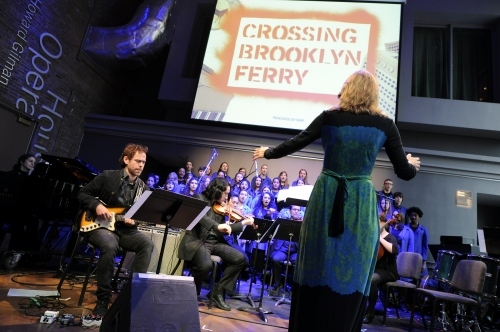
Guitarist Bryce Dessner performs with the Brooklyn Youth Chorus; photo by Mike Benigno, courtesy of BAM.
Upon experiencing Crossing Brooklyn Ferry, however -- the New York City festival that Bryce Dessner and Aaron Dessner of the band The National were commissioned by Brooklyn Academy of Music (BAM) to curate -- genre distinctions emerged more grossly superficial than ever before.
Conceptually, the approach of the brothers Dessner seemed straight-forward and unadorned --invite artists and musicians whom they liked and respected to perform. The performances throughout the three-day festival, which began on Friday, May 3, were distributed among three separate performance spaces at BAM: the intimate Rose Cinemas, which hosted both musical sets and the screenings of nine short films by Bill Morrison, Matthew Ritchie, and others; the versatile BAMCafé, the site of performances by a truly eclectic mix of musicians -- the Jack Quartet, Buke and Gase, yMusic, the Brooklyn Youth Chorus, and Oneohtrix Point Never among them; and the Howard Gilman Opera House, which functioned as a "main stage" for such artists as So Percussion, The Antlers, Tyondai Braxton, St. Vincent, My Brightest Diamond, and Beirut.
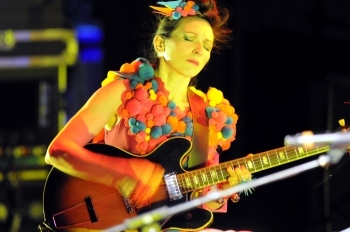
Shara Worden of My Brightest Diamond; photo by Mike Benigno, courtesy of BAM.
Above all, the genius of Crossing Brooklyn Ferry was in the logistics. The performances in each of the three venues overlapped with one another, with festival patrons moving freely from one space to the other. By design, one could catch the beginning 15 to 30 minutes of the film screenings, catch the middle of an Opera House performance, and then head upstairs to the café for the open bar and the end of another set.
The formality that audiences may have come to expect at performances by composer Judd Greenstein and The Yehudim, violist Nadia Sirota, the NOW Ensemble, and others was jettisoned. And by having three simultaneous options at any given time, the experience of the listener/viewer felt varied and organic. Yet because all of the scheduled performances are staggered, as opposed to scheduling acts during approximately the same block of times, the festival-goer had more genuine choices with which to craft an individual experience of musical discovery. Instead of the masses herding themselves from one stage to the next at the pre-appointed time, it seemed impossible that any two people had the exact same experience.
Apart from Bryce Dessner's annual MusicNOW Festival in Cincinnati, the Ecstatic Music Festival, established in 2011 by the above mentioned Judd Greenstein, is Crossing Brooklyn Ferry's most immediate and relevant predecessor. The creative circles of both Ecstatic and Brooklyn Ferry are essentially concentric; several artists, including My Brightest Diamond, So Percussion, Buke and Gase, yMusic, Missy Mazzoli and Victoire, Jherek Bischoff, and Richard Reed Parry of Arcade Fire have contributed to both festivals.
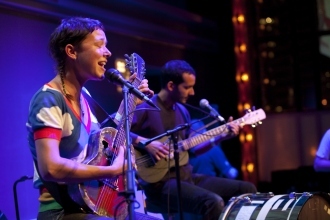
Arone Dyer, left, and Aron Sanchez of Buke and Gase; photo by Rebecca Greenfield, courtesy of BAM.
Such artists are inherently uninhibited by the dichotomy of vernacular versus formal, to which I had subconsciously adhered. And both festivals are excellent environments in which to be stylistically unencumbered.
But while each festival begins with the premise "Let's have makers of great music all play on one bill," the central conceits that Ecstatic and Brooklyn Ferry each project to their audiences differ in telling ways. The qualitative difference lies not in the music itself, but in the way the music is presented.
The Ecstatic Music Festival has from its inception clearly delineated which artist was more "classical" and which was more colloquial in each of its collaborative performances: So Percussion with Dan Deacon, Anonymous 4 with The Mountain Goats, composer Rhys Chatham with Oneida, etc.
But the mere acknowledgment of these genre distinctions lend them a validity that I sense is unintended. The result seems to be a contradictory concession of sorts that says using genre distinctions are vital to explaining why genre distinctions are unnecessary. The paradox is typified in the festival website's heralding of "contemporary 'post-classical' music." If labels were truly inconsequential and ultimately irrelevant, there would be no reason to employ them in the setup. Somehow, it undercuts the authenticity and dynamism of Ecstatic, and credence is given to the invisible yet still perceptible wall between classical and non-classical.
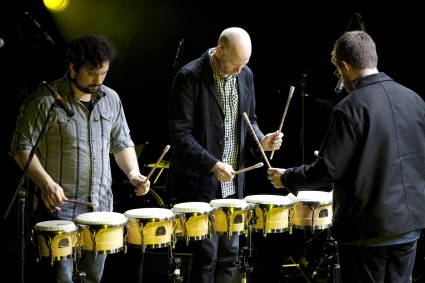
From left to right, Adam Swilinski, Jason Treuting, and Josh Quillen of So Percussion, photo by Rebecca Greenfield, courtesy of BAM.
The Crossing Brooklyn Ferry Festival seeks to showcase the aforementioned borough's music scene, but makes no effort to address genre at all. This approach suggests a way toward ensuring that the once obtrusive architectural eyesores of musical labels are not merely just invisible, but altogether intangible.
This article is cross-posted at postpostrock.com.
